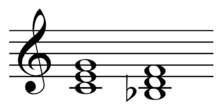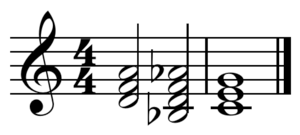Subtonic


In music, the subtonic is the scale degree below the tonic or, more specifically, the flattened seventh (♭VII): the lowered or minor seventh degree of the scale, a whole step below the tonic, as opposed to the leading tone, which is only a half step below the tonic.[1] The distinction between leading tone and subtonic has been made by theorists since at least the second quarter of the 20th century.[2]
The subtonic appears in three forms: as the scale degree, ♭, melodically and as the chord ♭VII in both ♭VII-I cadence and in modulations harmonically.[3] The word is also used as an English translation of subtonium, the Latin term used in Gregorian chant theory for the similar usage of a tone one whole step below the mode final in the Dorian, Phrygian, and Mixolydian modes.[4]
For example, in the A minor scale (white keys on a piano, starting on A), the subtonic is the note G (in C major this would be B♭); and the subtonic triad consists of the notes G, B, and D (in C: B♭-D-F). In music theory, the subtonic chord is symbolized with the Roman numeral ♭VII for a major triad built on the note, or ♭vii for a minor triad; in a minor key, the flat symbol is sometimes omitted by some theorists because the subtonic note appears in the natural minor scale, but the flat symbol is usually used for the major scale because the subtonic is a non-scale note.

In jazz, the flattened seventh is also used as a substitute for the dominant, V, especially in the Backdoor cadence,[5] ii-♭VII7-I, where the subtonic is used for the dominant seventh. ♭VII is in this case a pivot chord borrowed from the parallel minor (its dominant seventh). V7 and ♭VII7, the subtonic seventh chord, have two common tones, in C: GBDF and B♭DFA♭.
However, while, "the leading-tone/tonic relationship is axiomatic to the definition of common practice tonality," especially cadences and modulations, in popular music and rock a diatonic scalic leading tone (i.e., ♮-) is often absent.[6] In popular music, rather than "departures" or "aberrant," the "use of the 'flattened' diatonic seventh scale degree...should not even be viewed as departures".[7]
See also
Sources
- ↑ Bruce Benward and Marilyn Nadine Saker, Music: In Theory and Practice, vol. 1, seventh edition (Boston: McGraw-Hill, 2003), p. 33. ISBN 978-0-07-294262-0.
- ↑ Donald Tweedy, Manual of Harmonic Technique Based on the Practice of J. S. Bach (Philadelphia: Oliver Ditson Company, 1928), p. 7.
- ↑ Allan Moore, "The So-Called 'Flattened Seventh' in Rock", p. 185, Popular Music, Vol. 14, No. 2 (May, 1995), pp. 185-201.
- ↑ Julian Rushton, "Subtonic", The New Grove Dictionary of Music and Musicians, second edition, edited by Stanley Sadie and John Tyrrell (London: Macmillan Publishers, 2001); Harold C. Powers, "Subtonium", The New Grove Dictionary of Music and Musicians, second edition, edited by Stanley Sadie and John Tyrrell (London: Macmillan Publishers, 2001)
- ↑ Jerry Coker, Elements of the Jazz Language for the Developing Improvisor (Miami: CCP/Belwin, Inc, 1991), p. 82. ISBN 1-57623-875-X.
- ↑ Moore (1995), p.187.
- ↑ Moore (1995), p.186.
Further reading
- Stell, Jason Travis. 2006. "The Flat-7th Degree in Tonal Music". PhD diss. Princeton: Princeton University.